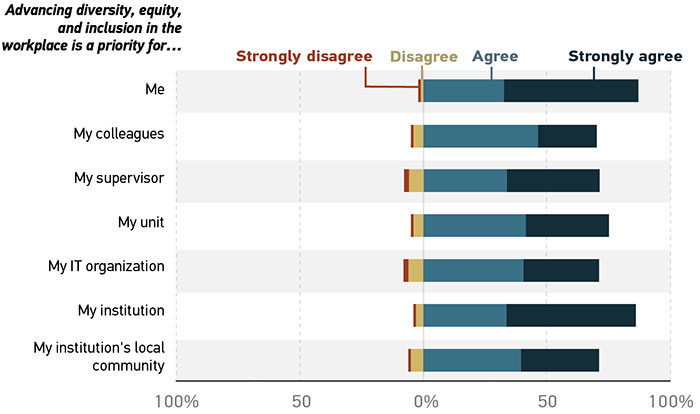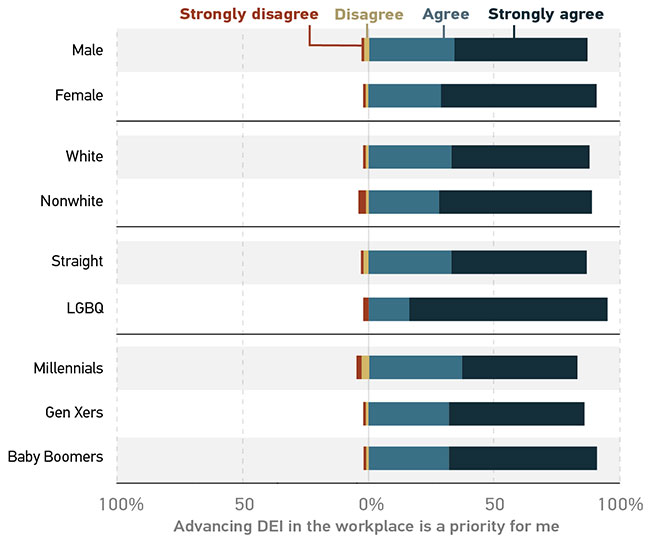DEI a Priority for Self, Less So for Others
We asked higher education IT employees to tell us how much they thought DEI in the workplace is a priority for themselves, their colleagues, various parts of the institution, and the local community. For every entity we asked about, more than 70% of respondents agreed that DEI in the workplace is a priority (figure 2). However, individual respondents rated themselves and their institution significantly higher in terms of their prioritization of DEI compared with their colleagues, supervisor, unit, organization, and community.

There are at least three possible explanations for these observed differences in how individuals view themselves and others around them. It could be that the findings are simply true to the sample; that is, the individuals who responded to our survey really do prioritize and see their institution as prioritizing the advancement of DEI in the workplace more than their peers, managers, IT units, and communities. Another explanation suggests the possibility of a Lake Wobegon1 effect, a condition in which everyone overestimates their own capabilities or tendencies in relation to others. This form of cognitive bias, scientifically known as illusory superiority, also allows for the diminishing of others on the same traits in order to elevate one's own standing. A third, related phenomenon that might help explain the significantly higher ratings of DEI prioritization for oneself and one's institution is that of social desirability bias, in which survey respondents answer questions in ways that may be viewed more positively by the interviewer. This may lead to an overreporting of desirable behavior and an underreporting of undesirable behavior and can sometimes include the diminishing of others in order to elevate one's own desirability. If being seen as supporting the advancement of DEI in the workplace is a desirable trait, our results may be biased in the direction of agreement. Despite the potential presence of these forms of bias in our responses, however, our data suggest that most higher education IT employees believe that their colleagues, institution, and community support the ideals of DEI in practices, policies, and outcomes.
When we take a deeper dive into the data, we find that advancing DEI in the workplace is more of a priority for female, nonwhite, LGBQ, and older IT professionals than for male, white, straight, and younger professionals (figure 3). While a supermajority of respondents overall agreed or strongly agreed that DEI is a priority for them, the intensity of that prioritization appears to be higher for nontraditional groups. For example, more women (62%) strongly agreed that advancing DEI is a priority for them than do men (53%); those who identify as LGBQ (79%) are more likely to strongly agree than those who identify as straight (54%). Whites (88%) and nonwhites (89%) are practically identical in terms of their overall agreement about DEI's priority for them, but more nonwhites (61%) than whites (55%) strongly agreed.

The one surprising finding among these comparisons is that older IT professionals prioritize advancing DEI more than do younger ones. DEI might be construed as being based upon a set of progressive or postmaterialist2 values that emphasize self-expression and quality of life, values that tend to be closely associated with younger generations. Thus, that Millennials prioritize DEI at levels significantly lower than Boomers seems counterintuitive. However, Boomers might see the ageism that leads to their being forced out of long-held positions or being passed over in favor of younger, more affordable talent as part and parcel of a DEI issue. We may also be observing the trickle-down effect caused by the tendency of older generations to hold more higher-ranking positions and therefore feel they have a greater ability to influence the entire workplace.
Notes
-
In the radio program A Prairie Home Companion, Garrison Keillor always closed his stories from Lake Wobegon with the descriptive tagline of the town's being a place where "all the women are strong, all the men are good-looking, and all the children are above average." Justin Kruger, "Lake Wobegon Be Gone! The 'Below-Average Effect' and the Egocentric Nature of Comparative Ability Judgments," Journal of Personality and Social Psychology 77, no. 2 (1999): 221–232.
↩︎ -
For a basic overview, see Postmaterialism.
↩︎